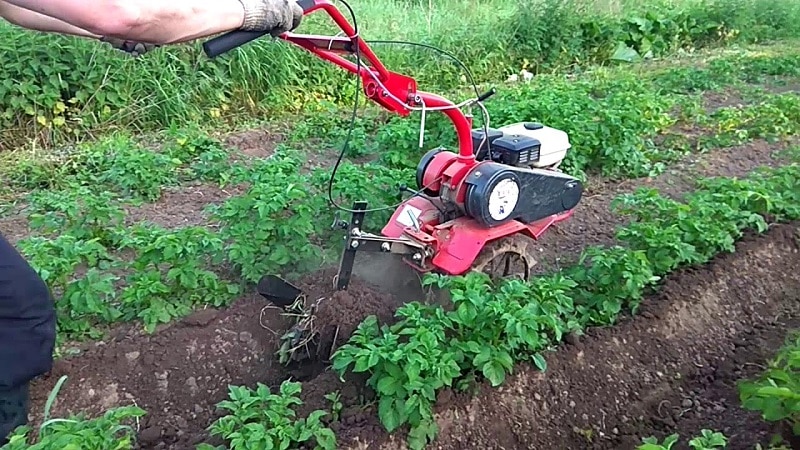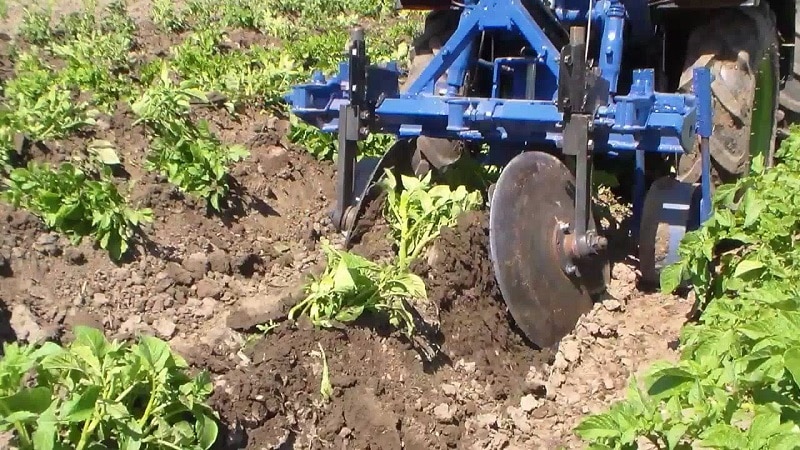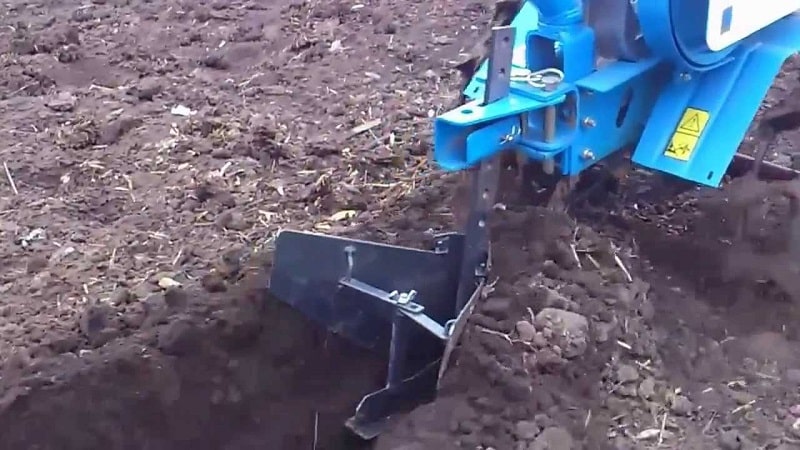Technique for hilling potatoes with a walk-behind tractor
Every vegetable grower involved in growing potatoes, is interested in the crop harvest being as large as possible, and the labor and time costs for obtaining it being less. Using special equipment helps achieve the desired results. We'll tell you how to hill potatoes with a walk-behind tractor in this article.
What is a walk-behind tractor
Myself the term “motoblock”, if we consider it in general technical terms, means a single unit with built-in elements: clutch, transmission and engine. The device differs from a multicultivator in the presence of a transmission output for connecting additional equipment.
Reference. A walk-behind tractor is a self-propelled power transport unit based on a single-axle chassis, equipped with additional attachments for performing various agricultural work. This universal device is also called a mini-tractor.
The equipment is equipped with two long handles for control. The engine is started with a cord, like an electric starter or a chainsaw, and the presence of a gearbox makes it possible to regulate the speed of movement.

The devices differ according to the type of motor, which can be:
- diesel;
- electric;
- gasoline.
Motoblocks with a gasoline engine are used most often.
Connecting active attachments also varies. There are walk-behind tractors with:
- power take-off shaft;
- additional pulley.
Another difference is the location of the cutters:
- lower;
- rear
Using a walk-behind tractor, depending on its power and the use of different types of attachments, you can:
- cultivate the land, performing almost all types of gardening work;
- transport goods;
- mow lawns;
- remove snow.
One of the functions of the walk-behind tractor is hilling potatoes using a mounted hiller, which raises the furrows to provide air access to the plant tubers. The unit greatly facilitates the process: when passing it in one direction, a furrow is laid, and when returning, the depression is evenly filled with soil to a certain height.
To install the hiller on a walk-behind tractor:
- The plow stand is inserted into a special lock and secured with 2 bolts.
- Connect the hitch.
- Attach the finished structure to the walk-behind tractor.

Why do they hill up potatoes?
Hilling — adding soil to the lower parts of the plant is a mandatory procedure, used in growing potatoes, and is carried out with the aim of increasing crop yields.
Loosening the soil around the bushes is necessary to:
- Increase resistance to frost and adverse weather conditions. In the spring, when there is still a chance of late frosts, and tender shoots have already appeared, it is useful to cover them with soil to increase planting depth and provide resistance to hail, wind and rain.
- Remove crust from the soil surface. Loose soil allows air to pass through well, which allows the roots of the plant to be saturated with oxygen, and also facilitates the access of moisture to the root system.
- Increase the number of stolons - shoots on which tubers are formed.A layer of soil sprinkled on top ensures the development of a more powerful root system, the setting of new tubers on side shoots, the activation of metabolism and the growth of green mass.
- Prevent greening of tubers. Sprinkling the bottom of the plant with soil prevents the vegetables from turning greenish. It occurs on tubers that sit shallowly and climb to the surface. Such potatoes contain poisons and are not suitable for consumption.
- Get rid of weeds. This will protect the culture from oppression, damage to the presentation and, as a result, will extend the shelf life of the product.
- Simplify plant care and harvesting. As a result of regular hilling, the rows of potatoes are clearly distinguished, which makes it convenient to spray the crop and facilitates digging up the bushes after the tops have dried.
When
The first hilling is carried out when the sprouts reach 5-10 cm, the second - when the bushes rise by 20-30 cm. In the future, the procedure is repeated every 2 weeks until the start of flowering.
For early potato varieties, a one-time hilling is sufficient.. It is carried out before flowering, during the formation of tubers.
Attention! In order for potatoes to develop successfully, they must be hilled several times a season.
How to properly spud
Hilling rules:
- The most favorable time for the procedure is after rain, when the soil is slightly moist. In the absence of precipitation, the soil is moistened artificially.
- In hot weather, the plant should not be hilled, as this will cause it to wither.
- It is best to carry out the procedure in cloudy weather, as well as after sunset or early in the morning.
- The rows should not be made very thin so that the bushes do not begin to dry out.
- It is necessary to maintain the same distance between rows so as not to injure the tubers.
- During the first hilling, when there is still a danger of frost, the soil is poured as high as possible. This will not interfere with the successful growth and development of the plant.
- At high air temperatures, it is necessary to sprinkle the lower parts of the bush with soil only slightly, otherwise the growth of shoots will slow down.

Features of hilling with a walk-behind tractor
In order not to damage the tubers during the process of hilling potatoes using a walk-behind tractor, but to bring maximum benefit to the plants, it is necessary to take into account the peculiarities of such processing:
- width between rows should be 65-70 cm - the unit will pass freely and work efficiently;
- to more accurately determine this value, you need to measure the distance between the wheels of the device and add another 10 cm to it;
- When hilling for the first time, it is important to set up the hiller correctly - so that the earthen ridge is low and narrow;
- It is useful to completely cover the bushes with soil - this stimulates their growth and protects them from damage by insects;
- during subsequent hillings, adjust the device so that the ridge is higher and wider, and a soil cushion of optimal size is formed around the bushes - 20 cm.
Difficulties may arise when planting crops densely with the passage of equipment and damage to tubers.
Advantages
Planting potatoes with a walk-behind tractor with a hiller has the following advantages:
- The use of technology during the growing season allows you to hill up the plant in the shortest possible time and thereby protect it from death.
- Using a hiller speeds up the process: the amount of work done manually in a day can be done in a few hours using the unit.
- Obtaining a deeper furrow than with manual processing prevents the bushes from falling to one side.
- The complexity of the procedure is significantly reduced.
- When hilling with a walk-behind tractor, the soil is compacted minimally and becomes looser, which increases air exchange and promotes saturation of the roots with air and intensive growth of tubers.
- Loosening is accompanied by high-quality removal of weeds, which also has a positive effect on the harvest.
Among the advantages of the walk-behind tractor it should be noted its high maneuverability and low fuel consumption.
Types and technology of using hillers
There are various types of devices used for hilling potatoes.. These can be discs or wedges, which are installed on the walk-behind tractor using special fasteners. The units have their own design features and differ from each other in operating principles.
Disk
The device includes:
- 2 equally directed disks;
- screw regulators;
- T-shaped leash.

Attached to frame During operation, the discs lift the soil and rake it towards the bush.
Important! To obtain the desired height of the soil ridges, set the appropriate furrow width and slope angle.
Disk hiller provides:
- evenly sprinkling the plant with soil on both sides;
- formation of smooth high ridges;
- looser soil due to its grinding.
Unit easy to use and low energy consumption.
Before starting work, set:
- the position of the disks relative to each other, determining the nature of the ridge by widening the lower part and narrowing the upper part;
- the distance between the discs depending on the row spacing;
- the angle of inclination of the frame relative to the horizontal plane.
The unit is installed on the treated area so that the furrow passed strictly between the disks of the motorized cultivator, and the bushes remained untouched.
Attention! Since the disc hiller processes only one central row, after turning you need to walk 2 times along one row.
plow-shaped
Devices of this type are single-row and double-row.
Single row
The design of a single-row hiller is extremely simple — 2 plates arranged in a wedge. It is easy to assemble, but there is no adjustment and only makes one furrow per pass. The device is used for processing light soil.

Work order:
- The machine is equipped with wheels with minimal outer edges so that it requires a short distance between the rows.
- Adjust the depth of depth.
- Start hilling.
Double row
Unit has an improved design: It can be adjusted to adjust the width and depth of the treatment, and also make furrows on both sides of the planting at the same time, which greatly simplifies the process.
First, set up the device:
- Depending on the soil, the depth of depth is selected and set, and the walk-behind tractor must be on a flat horizontal surface.
- The angle of inclination is adjusted by the position of the rack, deflecting it forward when it is too deep and backward when it is not deep enough.

Double row plow unit the central row is covered entirely, and the side rows - half. When returning, it is directed through one row spacing so that the wheel passes between the rows only once.
Propeller
On the crossbar of this device there are propellers with teeth, standing in parallel.Such devices allow you to use the walk-behind tractor not only for hilling potatoes, but also upon landing and harvesting.
For high-quality operation of the propeller walk-behind tractor, a universal hiller and a motion stabilizer (keel) made of 4 mm thick sheet metal are attached to the hitch.

Active propeller-type hiller in operation:
- loosens the soil;
- removes weeds;
- scatters oxygenated soil on both sides.
Universal hiller on a hitch:
- acts as a brake;
- levels the beds.
The keel stabilizes the movement of the device, ensuring its smooth passage between the rows and facilitating control of the unit.
Listerny
The design of the device is simple, without adjustment, with an initially set fixed width of 25-30 cm. The plow attached to thin posts has even wedges and does not give a large load on the walk-behind tractor when it is immersed in the ground. The use of concave wedges prevents strong eversion and drying out of the soil.

First, install the wheels and hitch on the walk-behind tractor, and then attach the hiller. The unit is placed on a flat surface, and the tip of the device is lowered below ground level to a specified depth, which is set using a retractable leg located at the back of the device.
During operation, the device lifts the soil with a cutter. Its wide dumps distribute the soil from the center to the edges, forming a ridge. It is not recommended to treat soil that is too wet with a lister hiller to avoid soil sticking.
Reference. A lister hiller is used to process narrow row spacing on devices with a capacity of up to 3.5 liters. With.
Recommendations from experienced gardeners
Experienced summer residents advise:
- Before starting work, carry out a test hilling to determine the optimal immersion depth, adjust the angle of inclination, and set the speed of movement. As a result of correct settings of all parameters, the unit will move along the specified path without touching the potato bushes.
- The first hilling should be carried out at low speeds. This will allow you to properly loosen the soil between the rows and notice errors in a timely manner.
- When a light walk-behind tractor slips while cultivating too dense soil, weighting agents are used. It is recommended to install monolithic disc weights or pre-fabricated and concrete-filled hollow loads on the wheels.
- Although the last, third, hilling can be skipped, it is still better to carry it out 2 weeks after the second, adding soil to the maximum height.
Conclusion
Using a walk-behind tractor for hilling potatoes on a dacha or farm plot greatly facilitates the work of a vegetable grower, speeds up the process and improves its quality. Choosing a suitable unit and following the recommendations for its use will ensure a bountiful harvest without loss.